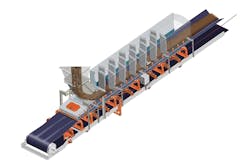Editor’s note: Processing asked industry leaders to comment on major trends and key developments they see as continuing or emerging in their industry/equipment sector as part of a larger forward-looking piece in the October 2017 print issue celebrating 30 years of publication and looking ahead to the next 30 years. See additional responses in “The process industries: A look ahead to the next 30 years.”
Having worked in conveyor design and engineering for over three decades, I see primarily two separate markets using conveyor belts. One is in process industries such as food, chemical, paper, cement and power, where the bulk materials entering the processes are generally of a consistent size and quality and handled in relatively low volumes. The other market is mining, where the bulk materials’ quality and size vary considerably, and the volumes are typically much greater.
While both segments face similar issues with safety and environmental control, the properties of the materials handled and the volumes transferred will make the approaches different, with one thing in common: increased speeds requiring modern equipment upgrades.
Space constraints in the factory, along with throughput limitations of processing equipment, generally cause narrower conveyor belt widths for processing applications. I don’t see this changing. Instead — to accommodate a higher capacity — belt speeds will increase, demanding a greater need for maintenance and control of fugitive materials. Also, processing companies will continue to seek lower-cost raw materials, which generally means smaller particle sizes. These factors require dust and spillage control, expanding the use of specialty systems, such as pipe conveyors and innovative enclosed conveyor designs.
To drive down the cost per ton of conveyed material, the mining sector will install wider and faster troughed conveyor belts. Although flat belts are well suited for high tonnage conveying, I don’t predict a drastic shift away from the traditional troughed design. With the push toward wider and higher speed belts, the industry will need substantial development in more reliable components, such as idlers, impact beds and belt cleaners.
The quality of the ores will continue to degrade, as the best and most accessible reserves are gradually depleted. This will lead to mine development in more extreme environments, such as arctic and undersea deposits.
Safety pays
With companies realizing that safety does indeed pay, safety will become a new source of cost reduction. The percentage of mines and processing facilities with a robust safety culture will increase over the next 30 years to the point where it is the norm, not the exception.
Conveyor monitoring tied to safety and to predictive maintenance will become increasingly reliable, allowing conveyors to autonomously operate and predict maintenance needs. Eventually, robots will take over many of the dangerous production jobs, particularly in underground mining as the ROI for safety provides additional justification.
As experience maintenance personnel retire, younger workers entering the market will face special challenges, with safety and maintenance skills becoming more sophisticated and essential. While still required to possess basic mechanical knowledge, new maintenance personnel will also need a greater technical understanding. This division of work requirements will make it difficult to find people with multiple skill sets, helping to drive the outsourcing of specialized maintenance.
Processing and mining sites will attract more urban development, highlighting environmental issues. To improve emissions and safety, while reducing costs, a primary objective will be control of fugitive materials. Noise pollution will become a significant issue, necessitating the development of quieter systems and components.
Ultimately, moving large quantities of bulk materials inexpensively and safely will result in the development of many new and higher capacity semiautomated bulk transfer sites. Previously fed by truck, train or barge, long overland conveyors transporting materials from the mine or quarry site to storage or processing facilities may even impact the transportation sector.
R. Todd Swinderman is CEO Emeritus of Martin Engineering.
About the Author
R. Todd Swinderman
R. Todd Swinderman is president emeritus of Martin Engineering, a global innovator in the bulk material handling industry for more than 80 years, developing new solutions to common problems and participating in industry organizations to improve safety and productivity. The company’s series of Foundations books is an internationally-recognized resource for safety, maintenance, and operations training, with more than 22,000 print copies in circulation around the world. The 500+ page reference books are available in several languages and have been downloaded thousands of times as free PDFs from the Martin website. Martin Engineering products, sales, service and training are available from 18 factory-owned facilities worldwide, with wholly owned business units in Australia, Brazil, China, Colombia, France, Germany, India, Indonesia, Italy, Malaysia, Mexico, Peru, Spain, South Africa, Turkey, Kazakhstan, the US, and UK. The firm employs more than 1,000 people, approximately 400 of whom hold advanced degrees. For more information, contact [email protected], visit www.martin-eng.com, or call (800) 544-2947.
